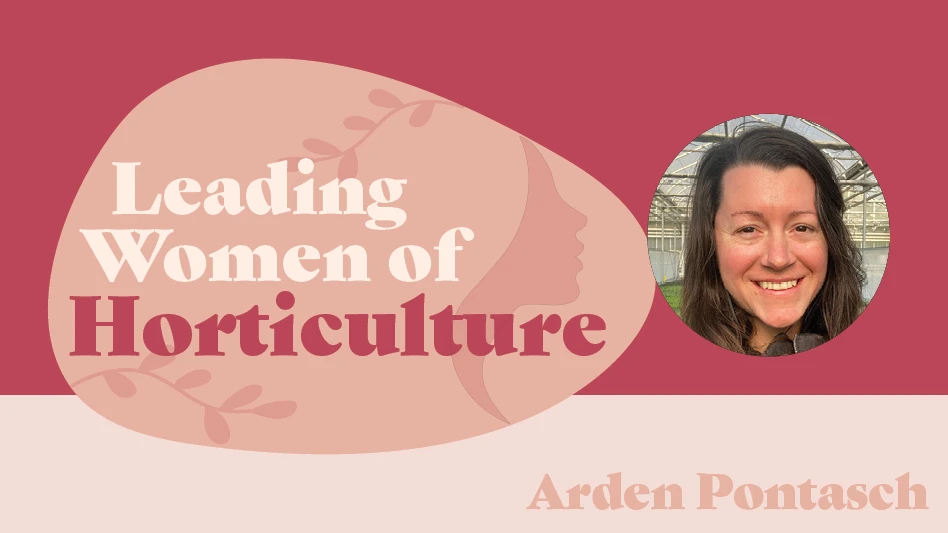

Often the consumer visits a garden center looking for something in particular, be it a tree, shrub, flower or vegetable. Many times, our industry can satisfy their need, but sometimes there is just that one plant that half the gardeners in the area want. The same goes for the trade. It’s the one they saw in a magazine, at a trade show or in a press release. What makes people want that plant so badly that they may go from store to store or source to source looking for it? (I have been guilty of doing the same thing — looking for the one particular Holy Grail of plants.)
It’s called horticultural marketing, and the woman who brought the industry to the forefront of it is Dr. Bridget Behe.
Behe, a native Pennsylvanian, was brought up near Penn State in Centre County, Pa. She says her two grandmothers were very influential in her horticulture career choice. Her maternal grandmother was a great flower grower and was even a rose “tester” for Jackson & Perkins. Her paternal grandmother was a great vegetable gardener.
Studying horticulture made perfect sense when it came time to go to college at Penn State. As she was nearing graduation, she interviewed with an influential greenhouse owner. She hoped to work there until he told her he was reluctant to hire her because she would be soon married and pregnant in no time and he would have wasted his money in training her. She was devastated by his remark. This was in 1982, long after the 1964 Civil Rights Act which includes Title VII that made it illegal for employers to discriminate against any individual on the basis of “race, color, religion, sex, or national origin.” And yet it happened then and happens more subtly now. Behe said she was raised to believe she could do anything that any other person could do.
She has been known to say that “we’re all the same from the neck up,” meaning that men and women are equally capable of doing the same work, although she believes that women sometimes look at things differently. Behe says that discrimination is still there although it is “getting better” and that the “#metoo movement will speed up that process.”
In pursuit of education
Instead of going into the greenhouse business, she decided to attend graduate school. She considered Penn State, but was encouraged to broaden her horizons and look at other universities. She was intrigued by a program at Ohio State University led by Dr. Jerry Robertson. Although an agriculture economist by training, he was a professor in the horticulture department who was working on floral marketing issues. She was able to land an assistantship with him but unfortunately he was killed in an auto accident just six months after she started her master’s degree. She pleaded with professors in the Ag Econ, Horticulture and Marketing departments to let her continue the work, and this group of professors helped her through to graduation.
She received a grant from the Produce Marketing Association because there was no Floral Marketing Association yet. Her thesis covered consumers who bought flowers in supermarkets since, at the time, it was a new trend and market segmentation of florist consumers. Dr. Denny Wolnick from Penn State had an assistantship for a Ph.D open and she had been offered a job in California working in the industry on floral marketing. She took both the assistantship and continued her coursework in advanced consumer behavior and multivariate statistics. Multivariate statistics is a subdivision of statistics encompassing the simultaneous observation and analysis of more than one outcome variable. The application of multivariate statistics is multivariate analysis. As graduation loomed in 1989, there were few departments that were interested in the marketing aspect of horticulture.
She became the first female in the Horticulture Department at Auburn University in Alabama in the tenure stream. At Auburn her work consisted of floral and ornamental research, she was the greenhouse extension specialist, she taught classes, and was charged with gathering funds, including monies for graduate students.
When Michigan State University had an opening for a new faculty member, the job description was broadly written, calling for someone who was a plant nutrition expert, knew marketing and was able to teach. Behe finished her 20th year at Michigan State last August. At Michigan State, Behe investigates the consumer perspective of the horticulture industry for both edible and ornamental crops.
Practical applications
Her eye-tracking technology research can offer some critical insight to the industry, although she says the learning curve can be intense. Eye-tracking technology can help determine the location of pricing and other sign placement in garden center displays. Other research includes a study on how consumers look at plants displays with and without any posted pricing.
She’s been surprised at the difficulty in getting the industry to fund consumer research studies.
“Marketing is only a crisis when the firm is close to bankruptcy. It’s been a big challenge — surprise — how tough it’s been to get industry funding,” she says.
So how can the industry use her research to its advantage?
“Most companies don’t have the resources — people, knowledge, money — to collect their own consumer research. My results are designed to benefit different sized firms and ones from different geographic locations,” she explains.
Behe has “a big heart for the industry and has a passion for helping green industry businesses be more successful,” says Dr. Charlie Hall, the Ellison Chair in International Floriculture at Texas A&M University, and a fellow research collaborator.
“Bridget has enabled folks all across the green industry to peer into the minds of their consumers to see what makes them tick. She is a pioneer in using innovative market research techniques that provide insight regarding the purchasing habits of consumers and the analytics underlying their decision-making. And on top of that, she's a delightful person and I'm proud to call her my friend," he adds.

Behe says there is much to learn about consumers. Some consumer information is available online from various resources including the census data and her work. She suggests that growers and retailers look at these sources, think about their marketing plan and incorporate one or two changes or new elements a year.
Sometimes, marketing communications are not a company’s priority and it is a continuous challenge. And sometimes it falls to the bottom of the list. Behe suggests assigning one person to execute communications and to increase electronic communications. Companies should also track effectiveness through Google analytics and email openings, and retailers should take some of the data from their point-of-sale systems.
She really enjoys leading consumer research projects, but also likes teaching undergraduate courses in marketing and management.
“I still love to see former students that I taught, both at Auburn and at Michigan State, as happy, productive industry professionals. And many are parents now, which is also fun to watch,” she says. “It’s been an interesting and fun adventure to reflect back on. I never set out to be a college professor, but this path gave me the flexibility to take care of our young son…who had severe asthma as a young child and a great husband who traveled quite a bit for his job, with no family nearby. Somehow we made it work out.”

Explore the August 2018 Issue
Check out more from this issue and find your next story to read.
Latest from Nursery Management
- Trends: Proven Winners 2025 perennial survey shows strong demand
- Online registration opens for the 2025 Farwest Show
- Sustainabloom launches Wholesale Nickel Program to support floriculture sustainability
- Plant breeding as an art
- Society of American Florists accepting entries for 2025 Marketer of the Year Contest
- American Horticultural Society welcomes five new board members
- Get to know Christopher Brown Jr. of Lancaster Farms
- American Floral Endowment establishes Demaree Family Floriculture Advancement Fund





